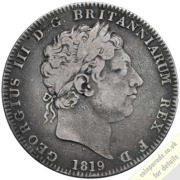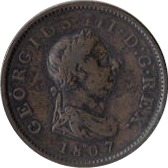
 The 1819 Crown - George III
The 1819 Crown - George IIIFollowing on from the New Coinage in 1816, Matthew Boulton and James Watt created steam-powered machines to produce good quality coins using silver content that was well below the face value of the coin. This design was minted 1818-1820 and is a large (37.6mm), attractive coin. Weight is 28.28g. SCBC: 3787.
The Reverse, by Benedetto Pistrucci, shows an image of St George and the Dragon enclosed in a garter. The design is often associated with gold sovereigns. The legend is "Honi Soit Qui Mal Y Pense", which is the motto of the Order of the Garter and means Shame on anyone who thinks evil of it.
Edge is inscribed. Number is LIX or LX showing the year of reign. There are several variations such as no Stops on edge, no Stops after TUTAMEN, a thicker ruled border and there is a 1819/8 overstrike.
 The Obverse shows a portrait of King George III, also by Benedetto Pistrucci. Note the use of Britanniarum Rex for King of Britain.
The Obverse shows a portrait of King George III, also by Benedetto Pistrucci. Note the use of Britanniarum Rex for King of Britain.Image credit: The Royal Mint
Mintage: Not known
Minted at The Royal Mint
More information (monarch, year, mint, country, category) can be found below coin listings.
Below are some coins currently being offered on eBay. As an eBay Partner, We may be compensated if you make a purchase.
List items on:
List items on:
Remember 1819 ?
In the UK: The Monarch is George III but due to illness his son George is Prince Regent. Prime Minister is Robert Jenkinson, 2nd Earl of Liverpool (Tory). Birmingham is lit by gas for the first time and used the Birmingham Gas Light and Coke Company. Queen Victoria is born (24 May) as Princess Alexandrina Victoria of Kent, Queen Regnant. A few months later (26 August) her future husband Albert is born.
In the USA: US President is James Monroe (DR-Virginia). Thomas Jefferson founds the University of Virginia. Spain cedes Florida to the United States. Arkansas Territory is created. SS Savannah sails from Savannah, Georgia to Liverpool, England and is the first steamship to cross the Atlantic Ocean; it took more than 29 days. Alabama is admitted as the 22nd U.S. state
In the USA: US President is James Monroe (DR-Virginia). Thomas Jefferson founds the University of Virginia. Spain cedes Florida to the United States. Arkansas Territory is created. SS Savannah sails from Savannah, Georgia to Liverpool, England and is the first steamship to cross the Atlantic Ocean; it took more than 29 days. Alabama is admitted as the 22nd U.S. state
George III (1760-1820)
 Born on 4 June 1738 to Frederick, Prince of Wales and Augusta of Saxe-Gotha in the house of Hanover, George III reigned for over 59 years.
Born on 4 June 1738 to Frederick, Prince of Wales and Augusta of Saxe-Gotha in the house of Hanover, George III reigned for over 59 years.George had 15 children - nine sons and six daughters. In the latter part of his life George suffered from a mental illness and his son George became Prince Regent from 1811-1820 and ruled on his behalf. On George III's death, the Prince Regent became George IV.
Note the latin spelling of George on his coins: Georgivs.
Category: Crowns
The Crown is a very old coin, with origins dating back to Henry VIII. The English Crown first appeared in 1526. It was made of 22 carat gold ("crown gold") and has a value of five shillings (a quarter of a pound).By 1551, silver was being used to produce crowns, although gold was sometimes still used. The silver crown was quite large, being about 38mm and weighing about one ounce. Around that time many Europeans countries had similar sized silver coins which made them good for international trade as they were essentially interchangeable.
The metal used was 92.5% silver and the rest copper so as to make the coin harder. This hardness, together with a milled edge, made 'clipping' (which was cutting slices off the edge to steal some free silver) more difficult.
After the Union of England and Scotland in 1707 a new coin, the British Crown, replaced the English Crown and Scottish Dollar. The value was set at 5 shillings and the size was 38mm in diameter and weighed about 1oz as before.
Now more of a commemorative coin
Although the coin was always part of the British coin family, its large size made it unpopular for general circulation and the half-crown was favoured as the de-facto largest coin in circulation. The Crown was more-or-less relegated to a commemorative coin.
The British economy, especially after the World Wars, took its toll on the crown too. From 1816-1919 the crown was 0.925 silver, this was reduced to 0.500 silver in 1920 and in 1947 the Crown became Cupronickel (75% copper, 25% nickel). The size standardised at 38.61 mm and (silver crown) weight of 28.276g (1 oz).
Although not in current circulation, the Crown is still legal tender. After decimalisation in 1971 the Crown was officially valued at 25 pence. In the Eighties we had inflation which brought in higher denomination coins like the pound coin and the two-pound coin, so the Government decided that the crown needed to be restored to it former glory as biggest denomination coin and the crown was re-denominated to £5 in 1990.
Today the Crown is once again made in silver and gold, usually to satisfy collectors and investors. There is a little confusion with this as there are Gold Crowns which are worth £5 but there is another five-pound Gold coin from the sovereign family - see the article on Gold £5 Coin or Gold Crown?
Which Mint: The Royal Mint
The Royal Mint is the designated place for the UK to mint coins. It dates back well over 1000 years and is a Government-owned company. Formed in the reign of Alfred the Great about the year 886, during the period 1279-1812 it was generally referred to as The Tower Mint as it was housed at the Tower of London. The Master of The Royal Mint has included famous figures such as Sir Isaac Newton.
Since 2010 it has operated as Royal Mint Ltd, a company owned by HM Treasury, under an exclusive contract to supply all coinage for the UK although it also produces medals and coins for other countries. It is currently located at Llantrisant, Wales.
Country of Origin: United Kingdom
The United Kingdom (UK) is the Union of England, Scotland, Wales and Northern Ireland. It is often refered to as Great Britain (GBR). It has a long, rich history. The orignal coinage was Pounds, Shillings and Pence but since decimalisation on 15 February 1971, it is £1 = 100p, that is One Pound = 100 pence. The coinage of the UK is also a long history, the Royal Mint being established as long ago as 886AD when coins were hammered. Today there is perhaps 30 billion coins in circulation, and many (numismatic) collectors coins and sets are issued frequently in gold, silver and other metals.








